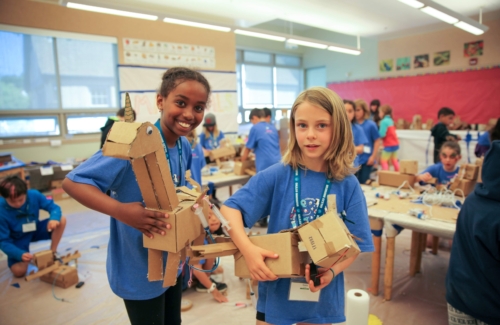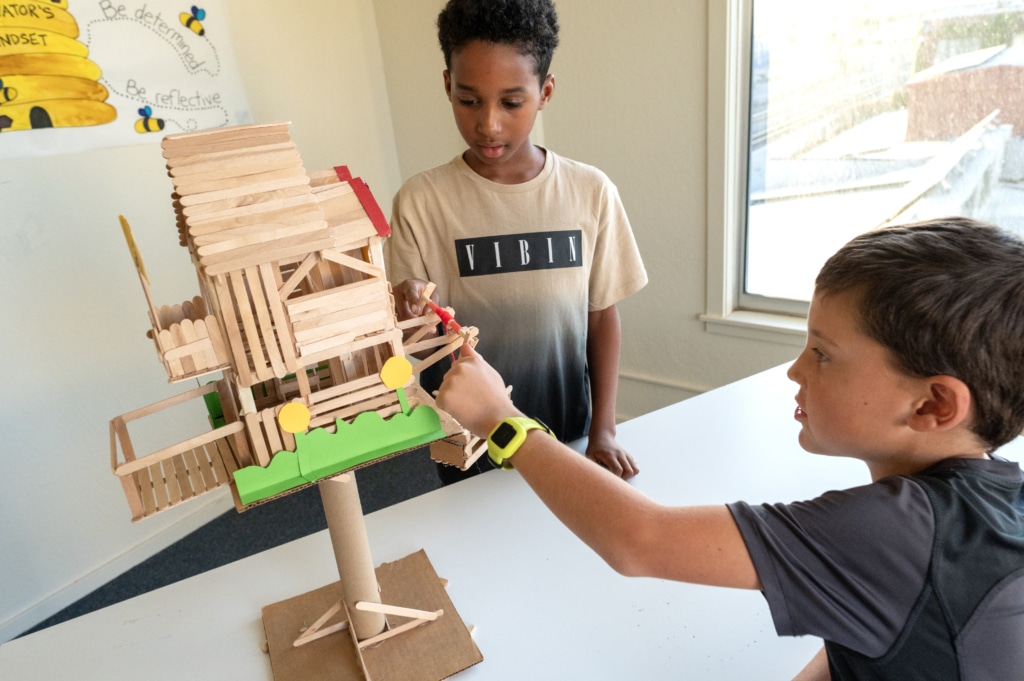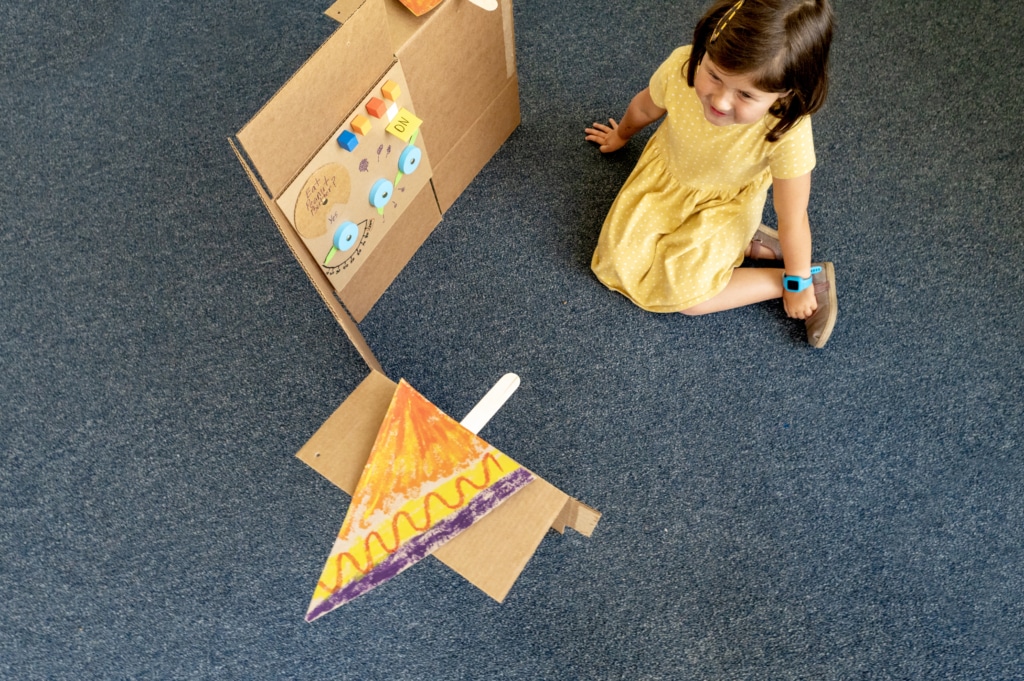What is Play-Based Learning?

As adults, we often distinguish between productivity and pleasure. Work is work, and play is play.
But what if play could also be productive? That’s the idea behind play-based learning.
We already know that play is an essential part of childhood. It promotes healthy social, emotional and physical development. It’s even included as a fundamental right in the United Nations Convention on the Rights of the Child!

With that in mind, play-based learning is an ideal way to approach childhood instruction. By blending playtime with education and exploration, play-based learning offers kids the best of both worlds.
Let’s take a closer look at the philosophy that’s becoming increasingly popular in schools, daycares and, importantly, at summer camps.
Play-Based Learning, Explained
In a nutshell, play-based learning says that learning and play can go hand in hand. It’s a strategy that emphasizes the role of fun in a child’s development, both inside and out of the classroom. In other words, play-based learning allows kids to learn through first-hand experiences and have a blast at the same time.
According to the experts, play-based learning can inspire two different kinds of growth in children. First, there’s the developmental standpoint; play can encourage emotional and physical maturation. Then, there’s the academic one; through play, children can improve their skills in math, reading, science and more.
Two types of play can promote learning:
- Free play – In free play, the children are in charge. They choose the activity, its duration and any rules that should apply.
- Guided play – In guided play, a teacher or guardian is involved in some capacity. For example, a camp counselor might suggest that the kids put on a play about knights in medieval times.
In both cases, studies have shown that play-based learning is an effective tool for educators looking to provide children with diverse educational experiences and real-world skills.
Essential Components of Play-Based Learning
While all forms of play are valuable, a specific set of criteria needs to be met for an activity to be considered “play-based learning.”
Ideally, all play-based learning should be:
- Entertaining – Above all else, play needs to be enjoyable. Without the fun element, play-based learning is just learning. All play-based learning activities should bring authentic joy to the participants.
- Child-directed – Play-based learning is most powerful when the children choose the what and how. Kids learn through making their own decisions, so they should be given opportunities to select activities. Naturally, adults can still be involved to some degree, but the kids should take the reins.
- Unstructured – As a process-oriented philosophy, play-based learning should ultimately be free and flexible. A lack of rigid structure allows children to learn and explore based on their preferences and strengths.
What Play-Based Learning Is Not
It’s worth noting that play-based learning is not “work in disguise.” There should be no real goal or ulterior motive behind the activity. If there is an objective to the game (such as learning the alphabet or practicing times tables), it’s not really play-based learning. Instead, it’s just a clever way of delivering a lesson.
Of course, there’s nothing wrong with that. It’s an educator’s job to ensure their students pick up essential competencies, especially when they’re teaching in public schools with curricula and report cards.
However, true play-based learning is fun and freeing. It offers kids a chance to be kids. And in the process, it indirectly teaches all kinds of important skills.
The Benefits of Play-Based Learning
Although play-based learning is often seen as a strategy for pre-kindergarten kids, the truth is that using play as a medium for instruction can be advantageous for all ages—even adults!

Still, play-based learning is most common among children whose brains are still developing. And there are countless reasons why.
Here are just some of the benefits of play-based learning for children.
Encouraging Creativity and Curiosity
For many children, the cornerstone of play is using “make-believe.” Any activity that engages the imagination allows kids to express themselves in millions of different ways.
When they play pretend, children create characters, themes and entire worlds. In play-based learning settings, adults can ask open-ended questions that encourage kids to reflect on their imaginary worlds and invent deeper, more intricate stories.
Of course, creativity serves kids throughout their childhood, but it also carries them into adulthood. From igniting passions like music and art to launching careers in design and film, creativity is an invaluable gift to the young mind.
Strengthening Problem-Solving Skills
Play-based learning also encourages experimentation and risk-taking, which can lead to obstacles. To continue playing, kids must overcome these obstacles with critical thinking.
For example, if some kids have decided to build a tower out of cards, they must discover strategies—on their own—for holding up the structure and building it ever higher. Through trial and error, these children will find an optimal design.
Put simply, play-based learning turns kids into solution-oriented innovators by empowering them to think for themselves. Instead of relying on an adult for help, they must trust in their own problem-solving skills.
Furthering Social and Emotional Development
In most cases, play-based learning is a group effort. As such, every game or puzzle is a chance to forge social skills. Kids playing together learn not only from the activity but also from each other. What’s more, they learn how to interact with each other.
To use our card tower example again, imagine a group of kids banding together to build a structure that supports their toy dinosaurs. In this simple scenario, the children practice social skills like:
- Collaboration
- Communication (verbal and non-verbal)
- Compromise
- Leadership
Play-based learning is equally valuable from an emotional perspective.
For instance, what happens when the tower falls? One child might feel dismayed; another may become angry with themselves or a fellow architect. Emotions like these come up naturally during play-based learning, and kids have the opportunity to identify and manage them.
Improving Physical Development
It gets better: Play-based learning isn’t only beneficial to the brain. Many games and activities involve movement, balance and coordination. These activities can contribute to a child’s physical health.
Depending on the game being played, children can improve their:
- Fine motor skills
- Muscular strength
- Hand-eye coordination
- Stamina
Additionally, play-based learning often takes place outside, giving kids more opportunities to take in fresh air and connect with nature—an activity that brings cognitive benefits of its own.
Fostering Inclusive Environments
Play-based learning can also introduce kids to different perspectives and promote tolerance. During play, children from all cultures and backgrounds bring their unique worldviews into the mix, especially when playing pretend.
When instructors take care to set up inclusive environments for children to learn and play in, the results can be spectacular. For example, a game of dress-up could include a handful of varied garments, each one with an explanation of its origin.
Reducing Stress
Play has even been shown to reduce stress. And since stress can detract from effective studying, play-based learning is an ideal medium for children hoping to pick up new skills.
Because children often learn in unfamiliar environments—such as daycares and new summer camps—play-based learning activities can help them ease into their surroundings during the first few days.
Examples of Play-Based Learning Activities
In theory, any play can become play-based learning. Below are some typical examples of play-based learning in action:
- Role-playing – Anything that involves story-telling and make-believe can be considered play-based learning. Instructors often support kids by giving them access to a stage with costumes and props. There, they can invent scenarios, act out scenes and solve imaginary problems.
- Building and engineering opportunities – For younger children, playing with building blocks or popsicle sticks is enough to spark the imagination. For older kids, challenges like designing a balsa wood bridge or crafting a paper airplane that can fly the furthest allow them to flex their problem-solving muscles.
- Artistic projects – Activities that foster creativity range from painting canvases to decorating cookies. Music and dance are also terrific examples of play-based learning; instructors can make instruments available during free play.
- Puzzles and board games – Word games like Scrabble and Boggle promote critical thinking and literacy, while games like Monopoly and Clue encourage communication and cooperation. Alternatively, instructors can provide the pieces and let the kids come up with their own games.
- Outdoor exploration – Sometimes, the best activity is an opportunity for a (supervised) journey out in the world. Kids can do a “show and tell” of the objects they find in the forest or field, and the adults can fill in any informational gaps.
Playing, Learning and Growing at Camp Galileo

For kids, play-based learning is the ideal way to absorb new knowledge. It’s a fun and informative approach that any kid can enjoy—because learning doesn’t feel like learning.
At Camp Galileo, we make every moment fun for the kids who attend. And through those exciting, entertaining experiences, each child comes away with lifelong skills and benefits.
From STEAM essentials to creative thinking, there’s plenty to discover at camp. What will your child learn through play?
Explore our locations across California, Colorado, Chicagoland and Seattle! Located in Southern California? Be sure to check out our Orange County summer camps! We have Camp Galileo locations across many communities. Explore our Camp Finder to find the locations nearest you.
Locate your camp to find out!
Explore our locations across California, Colorado, Chicagoland and Seattle! Located in Southern California? Be sure to check out our Carlsbad summer camp or our Irvine summer camps. We have Camp Galileo locations across many communities. Use our Camp Finder to find the location nearest you.

Sources:
Healthline. The Importance of Play: How Kids Learn by Having Fun. https://www.healthline.com/health/the-importance-of-play
United Nations. Convention on the Rights of the Child. https://www.ohchr.org/en/instruments-mechanisms/instruments/convention-rights-child
U.S. Department of Education. Portrayals of Play-Based Learning: Misalignments among Public Discourse, Classroom Realities, and Research. https://files.eric.ed.gov/fulltext/EJ1304727.pdf
Encyclopedia on Early Childhood Development. Defining Play-based Learning. https://www.child-encyclopedia.com/play-based-learning/according-experts/defining-play-based-learning
Frontiers in Education. Learning Through Play at School – A Framework for Policy and Practice. https://www.frontiersin.org/articles/10.3389/feduc.2022.751801/full
National Institutes of Health. Developing Children’s Creativity and Social-Emotional Competencies through Play: Summary of Twenty Years of Findings of the Evidence-Based Interventions “Game Program”. https://www.ncbi.nlm.nih.gov/pmc/articles/PMC9590021/
American Psychological Association. Nurtured by nature. https://www.apa.org/monitor/2020/04/nurtured-nature
UNICEF. Why play strengthens your children’s mental health. https://unicef.ch/en/current/blog/2022-06-27/why-play-strengthens-your-childrens-mental-health-en

